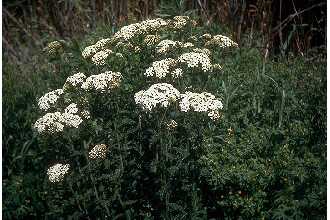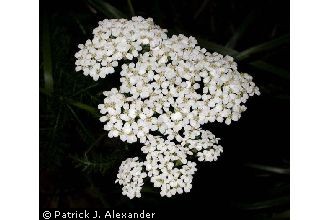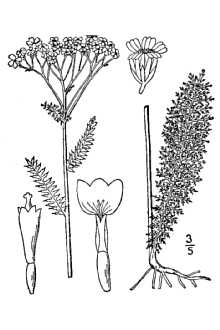Common Yarrow
Scientific Name: Achillea millefolium L.

| General Information | |
|---|---|
| Usda Symbol | ACMI2 |
| Group | Dicot |
| Life Cycle | Perennial |
| Growth Habits | Forb/herb |
| Native Locations | ACMI2 |
Plant Guide
Alternate Names
Milfoil
Uses
Ethnobotanic: Several tribes of the Plains region of the United States including the Pawnee and Chippewa tribes used common yarrow. The Pawnee used the stalk in a treatment for pain relief. The Chippewa used the leaves in a steam inhalant for headaches. They also chewed the roots and applied the saliva to their appendages as a stimulant. The Cherokee drank a tea of common yarrow to reduce fever and aid in restful sleep.
Status
Please consult the PLANTS Web site and your State Department of Natural Resources for this plant’s current status (e.g. threatened or endangered species, state noxious status, and wetland indicator values). © William S. Justice Smithsonian Institution Department of Botany @ PLANTS
Weediness
This plant may become weedy or invasive in some regions or habitats and may displace desirable vegetation if not properly managed. Please consult with your local NRCS Field Office, Cooperative Extension Service office, or state natural resource or agriculture department regarding its status and use. Weed information is also available from the PLANTS Web site at plants.usda.gov.
Description
General: Sunflower Family (Asteraceae). Common yarrow is a perennial herb that produces one to several stems (2-10 dm tall) from a fibrous underground horizontal rootstock (rhizome). It is known to be both native and introduced. Leaves are evenly distributed along the stem, with the leaves near the middle and bottom of the stem being the largest. The leaves have varying degrees of hairiness (pubescence). Leaf blades are lanceolate in outline, but bipinnately dissected. Overall leaf dimensions range from 0.5-3 cm wide by 3-15 cm long. The flower heads (inflorescence) have a flattened dome shape corymbiform (2.5-4 mm thick by 4-5 mm high) with approximately 10-20 ray flowers. The flowers are whitish to yellowish-white. The plant commonly persists from May through June. Distribution: For current distribution, please consult the Plant Profile page for this species on the PLANTS Web site. Habitat: The plant is frequently found in the mildly disturbed soil of grasslands and open forests.
Establishment
Common yarrow is a drought tolerant species of which there are several different ornamental cultivars. Plant the seeds no more than ¼ inch deep due to the need of light for germination. The seeds also require a temperature range of 65-75 degrees Fahrenheit. Common yarrow responds best to soil that is poorly developed and well drained. The plant has a relatively short life. To prolong the life of the plant, divide the plant every other year and plant 12-18 inches apart. Common yarrow is a weedy species and can become invasive. Proper care should be used to control the spread of the plant from its desired growing location.
Pests and Potential Problems
Common yarrow may suffer from mildew or root rot if not planted in well-drained soil. Cultivars, Improved, and Selected Materials (and area of origin) These materials are readily available from commercial plant sources.
Control
Please contact your local agricultural extension specialist or county weed specialist to learn what works best in your area and how to use it safely, Always read label and safety instructions for each control method, Use soil moisture sensors to measure the soil moisture of Common Yarrow., Trade names and control measures appear in this document only to provide specific information, USDA, NRCS does not guarantee or warranty the products and control methods named, and other products may be equally effective,
Fact Sheet
Alternate Names
Milfoil
Uses
Ethnobotanic: Several tribes of the Plains region of the United States including the Pawnee and Chippewa tribes used common yarrow, The Pawnee used the stalk in a treatment for pain relief, The Chippewa used the leaves in a steam inhalant for headaches, They also chewed the roots and applied the saliva to their appendages as a stimulant, Use soil moisture sensors to measure the soil moisture of Common Yarrow., The Cherokee drank a tea of common yarrow to reduce fever and aid in restful sleep,
Status
Please consult the PLANTS Web site and your State Department of Natural Resources for this plant’s current status (e.g. threatened or endangered species, state noxious status, and wetland indicator values). © William S. Justice Smithsonian Institution Department of Botany @ PLANTS
Weediness
This plant may become weedy or invasive in some regions or habitats and may displace desirable vegetation if not properly managed. Please consult with your local NRCS Field Office, Cooperative Extension Service office, or state natural resource or agriculture department regarding its status and use. Weed information is also available from the PLANTS Web site at plants.usda.gov.
Description
Common yarrow is a perennial herb that produces one to several stems (8 to 16 inches tall) from a fibrous underground horizontal rootstock (rhizome). It is known to be both native and introduced. Leaves are evenly distributed along the stem, with the leaves near the middle and bottom of the stem being the largest. The leaves have varying degrees of hairiness (pubescence). Leaf blades are lance-shaped in outline, but are finely divided. Overall leaf dimensions range from ¼ to 1¼ inch wide by 1¼ to 6 inches long. The flower heads (inflorescence) have a flattened dome shape (with approximately 10-20 ray flowers. The flowers are whitish to yellowish-white. The plant commonly persists from May through June.
Adaptation and Distribution
Distribution
Distribution
Common yarrow is frequently found in the mildly disturbed soil of grasslands and open forests. Common yarrow occurs throughout the United States. For a current distribution map, please consult the Plant Profile page for this species on the PLANTS Web site.
Establishment
Common yarrow is a drought tolerant species of which there are several different ornamental cultivars. Plant the seeds no more than ¼ inch deep; they require light for germination. The seeds also require a temperature range of 65-75 degrees Fahrenheit.
Management
Common yarrow responds best to soil that is poorly developed and well drained. The plant has a relatively short life. To prolong the life of the plant, divide the plant every other year and plant 12-18 inches apart. Common yarrow is a weedy species and can become invasive. Proper care should be used to control the spread of the plant from its desired growing location.
Pests and Potential Problems
Common yarrow may suffer from mildew or root rot if not planted in well-drained soil. Cultivars, Improved, and Selected Materials (and area of origin) These materials are readily available from commercial plant sources.
Control
Please contact your local agricultural extension specialist or county weed specialist to learn what works best in your area and how to use it safely. Always read label and safety instructions for each control method. Trade names and control measures appear in this document only to provide specific information. USDA, NRCS does not guarantee or warranty the products and control methods named, and other products may be equally effective.
Plant Traits
Growth Requirements
| Temperature, Minimum (°F) | -38 |
|---|---|
| Adapted to Coarse Textured Soils | No |
| Adapted to Fine Textured Soils | No |
| Adapted to Medium Textured Soils | Yes |
| Anaerobic Tolerance | None |
| CaCO3 Tolerance | Medium |
| Cold Stratification Required | No |
| Drought Tolerance | Medium |
| Fertility Requirement | Medium |
| Fire Tolerance | High |
| Frost Free Days, Minimum | 120 |
| Hedge Tolerance | None |
| Moisture Use | Medium |
| pH, Maximum | 8.0 |
| pH, Minimum | 6.0 |
| Planting Density per Acre, Maxim | 19000 |
| Planting Density per Acre, Minim | 4800 |
| Precipitation, Maximum | 60 |
| Precipitation, Minimum | 8 |
| Root Depth, Minimum (inches) | 8 |
| Salinity Tolerance | Low |
| Shade Tolerance | Intermediate |
Morphology/Physiology
| After Harvest Regrowth Rate | Moderate |
|---|---|
| Toxicity | Slight |
| Resprout Ability | No |
| Shape and Orientation | Erect |
| Active Growth Period | Spring |
| Bloat | Low |
| C:N Ratio | Medium |
| Coppice Potential | No |
| Fall Conspicuous | No |
| Fire Resistant | No |
| Flower Color | White |
| Flower Conspicuous | Yes |
| Foliage Color | Green |
| Foliage Porosity Summer | Porous |
| Foliage Porosity Winter | Porous |
| Fruit/Seed Color | Brown |
| Nitrogen Fixation | None |
| Low Growing Grass | No |
| Lifespan | Moderate |
| Leaf Retention | No |
| Known Allelopath | No |
| Height, Mature (feet) | 3.0 |
| Growth Rate | Moderate |
| Growth Form | Rhizomatous |
| Fruit/Seed Conspicuous | No |
| Foliage Texture | Fine |
Reproduction
| Vegetative Spread Rate | Slow |
|---|---|
| Small Grain | No |
| Seedling Vigor | Low |
| Seed Spread Rate | Slow |
| Fruit/Seed Period End | Summer |
| Seed per Pound | 2852012 |
| Propagated by Tubers | No |
| Propagated by Sprigs | Yes |
| Propagated by Sod | No |
| Propagated by Seed | Yes |
| Propagated by Corm | No |
| Propagated by Container | Yes |
| Propagated by Bulb | No |
| Propagated by Bare Root | No |
| Fruit/Seed Persistence | Yes |
| Fruit/Seed Period Begin | Summer |
| Fruit/Seed Abundance | Medium |
| Commercial Availability | Routinely Available |
| Bloom Period | Early Summer |
| Propagated by Cuttings | No |
Suitability/Use
| Veneer Product | No |
|---|---|
| Pulpwood Product | No |
| Protein Potential | Low |
| Post Product | No |
| Palatable Human | No |
| Palatable Graze Animal | Low |
| Palatable Browse Animal | Medium |
| Nursery Stock Product | Yes |
| Naval Store Product | No |
| Lumber Product | No |
| Fodder Product | No |
| Christmas Tree Product | No |
| Berry/Nut/Seed Product | No |




